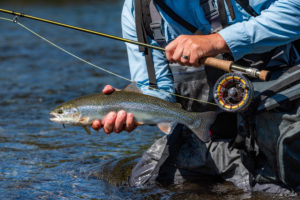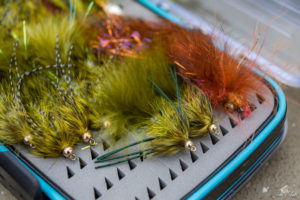From new fisherman to seasoned anglers, there’s always a need for quality, affordable fly fishing gear.
Did I just use “affordable” and “fly fishing gear” in the same sentence? Yes, I did. Whatever your experience level is, you can always be sure that at some point you’ll need a new rod and reel, a new fly box and all the other miscellaneous gear that is necessary for a good day on the water.
If you are new to fly fishing, welcome! This hobby may seem intimidating, but it’s not. In this article, I’ll cover all the gear you need to get started. If you’re not new to fly fishing, welcome! This article still has some great options for you to replace older gear.
Let’s dispel the myth that fly fishing requires a ton of expensive gear. There are lots of affordable fly fishing gear options out there.
To really get started fishing (and catching fish), you only need 7 essential items – that’s it! An important thing to note about these items is that you do want quality. You want these items to last you and to not fail when you do hook into a nice fish. Let’s discuss gear piece by piece.

1. Rod & Reel Combo
You can purchase these items separately, but if you’re new to the sport a combo outfit is a great way to ensure that you get a good setup. And, typically, a combo set offers better pricing. I always recommend Adamsbuilt outfits because they have a great price point and high quality gear. To determine the best rod & reel outfit for your needs, you do need to know where you’ll be fishing and what kind of fish are prevalent there. If you’re fishing in mountain lakes and streams for smaller trout, you could stand to use a 5wt rod and reel, whereas if you’re fishing for larger, inshore saltwater species like steelhead or salmon, you should opt for an 8wt.
You may be asking, “What do those numbers mean?” Well, fly rods come in sizes 2 – 14 “weight”, typically denoted as “w” or “wt”. The smaller the number, the smaller the rod. Fly reels are sized similarly, and as a general rule of thumb they should match the number of your fly rod.

2. Backing
You rarely see backing, but it is the material that connects your fly line to the reel and is an “insurance policy” in case your line isn’t long enough for a fighter. You may see your backing if you’re fighting a fish, but otherwise it will stay hidden under your fly line on the reel. Backing can be generally be purchased for around $15.
3. Fly Line
Fly line is attached to your backing and is typically 100′ long. Monic Fly Lines offers great line for a fair price, and they use eco-friendly materials. There are three main types of fly line: floating, sinking, and sinking tip. The first two perform exactly as they are named; floating line floats, sinking line sinks (with different “sinking speeds” available) and sinking tip line will float until about the last 10′ or so, which will sink.
Fly line is also numbered like fly rods and reels, but for the purpose of this article I suggest using your rod manufacturer’s recommended line weight.
And lastly, there are different fly line tapers: weight forward, double taper, and level taper. Weight forward line gets thicker toward the end of the line, and then tapers off toward your leader, allowing your cast to have a little more “umph” behind it. This is the most popular type of fly line. Double taper line is also a popular option, and features the thickest part of the line in the middle. Double taper line is typically used in smaller lakes and rivers to help with fly presentation. (Less weight on the end of your line means less weight crashing down on the water.) Level taper line is not as popular as the other two types because it has no real benefits to casting.
4. Leader and Tippet
Leader is usually a clear material that tapers towards the end, where your tippet material is connected. You can purchase multiple leaders (multi-packs) for under $20. Tippet is the same material as your leader, but is used to extend the length of your leader when needed or to decrease the diameter of your leader. Tippet can also be purchased in multi-packs for under $20. You want thin line, like tippet, at the end of your line to help make your fly look more natural. Your fly will be connected to the end of your leader (if it’s new, with a small diameter at the end) or to the end of your tippet (where you have extended your leader to be thin again). Throughout a day of fishing, your leader will decrease in length as you lose line to tying on new flies or breaking it off.

5. Flies
There are hundreds and hundreds of flies that you can buy, but you can’t expect to throw any ol’ fly out there and catch fish. There are a few categories of flies like dry flies, wet flies, nymphs, emergers and streamers. Flies vary in cost from under $1, up to over $3 per fly. The most important things you need to know when selecting your flies is:
- which bugs are “in season”
- the region that you’re fishing
- the species you’re fishing for
Here is a great article from The Catch and The Hatch about “3 Ways to Catch More Fish on Your Next Trip”, and they also have great courses for some in-depth information about fly selection.
6. Fly Box
Once you have your perfectly crafted fly assortment, you’ll want to protect that investment with a fly box. There are lots of options, but I recommend one that is water-proof and that floats (’cause accidents do happen). A reasonable, midsize fly box can be purchased for under $50.
7. Fishing License
An annual residential license will cost you less than $50 (depending on your state), although most state fishing licenses are even less than $20.
The Numbers Are In…
All in all, it is entirely possible to obtain all of these quality items for under $500.


